March 21, 2020 |
This article was originally published in WestView, a print publication in New York’s West Village.
Could a trained elephant slip through a bustling West Village dining room without so much as tipping a glass of red wine?
With business thriving in the 1960s, Fedora Dorato weighed the trade-offs of expanding the namesake restaurant she opened in 1952. Doing so meant it would double as an entryway for her neighbor’s elephant, Champagne. According to Ms. Dorato, the pet’s owner called her an “ass” for turning down the deal.
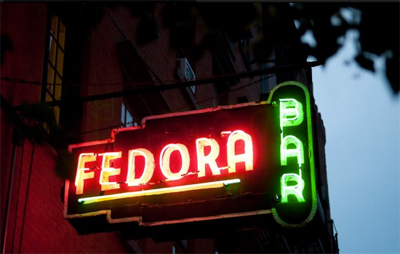
While Champagne never darkened Fedora’s door at 239 West Fourth Street, a thinning legion of regulars continues to visit this untouched window into the past. The tin ceiling, the rotary payphone, the wooden bar Ms. Dorato’s father-in-law once stood behind are not throwbacks to a bygone era; they never left.
On July 25, nearly 60 years after Ms. Dorato and her late husband Henry served their first plate of prawns Florentine, her staff will dish up their last.
Medical procedures have done little to ease Ms. Dorato’s relentless back pain, and she is finding it increasingly difficult to walk, let alone pour cocktails five nights a week. Still, the 89-year-old’s watery blue eyes dance when she speaks of her restaurant.
“I love the business. It’s very hard work if you’re fussy. I’m fussy,” said Ms. Dorato. “Sometimes a tablecloth is crooked. I pick it up and start from scratch.”
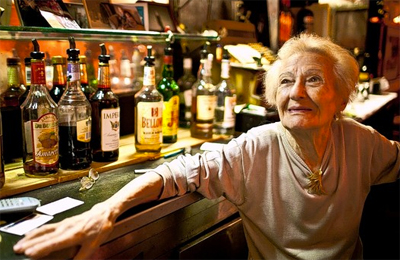
Since her husband passed away in 1997, Ms. Dorato has been in charge. While the dining room is quiet these days—patron Bill Shubick remembers a line to get in on his birthday in 1957—it remains a stubbornly unchanging source of camaraderie for a devoted group of silver-haired New Yorkers.
One Saturday night recently, Jerry Farley, a regular since 1974, entered the ground-level door carrying a martini glass in bubble wrap.
He unwrapped the glass at the bar. “Gin. I’m into gin tonight, a couple of olives,” he said to George Malmend, one of two waiters. Ms. Dorato sat nearby, resting her legs. Mr. Farley made his way to the sole round table—the “death table” he joked. It’s where he spent countless Saturday nights with friends who are no longer alive.
“This was an anchor for everybody,” he said. “Our friendship revolved around Fedora. When I come in here, I feel young again. Everything is just as it was.”
Later that evening, Rollerena—legendary in the 1970s for roller-skating with a magic wand in hand—walked in wearing a veiled hat, cat eye glasses, and baby blue fingerless lace gloves. The self-proclaimed “Queen of Studio 54” arrived after 8 o’clock, missing the warm applause that greets Ms. Dorato as she makes her entrance.
The petite restaurateur, though modest, adores the traditional ovation. “Sometimes I step back out just so I can hear it again,” she admitted with delight.
Ms. Dorato enters her establishment the way she wants everyone to feel: welcomed. Such a cordial atmosphere was difficult to find for gay men in the 1950s and 1960s. Villager Michael Rooney first came to Fedora more than 40 years ago with another young man. “She made everybody feel special,” he said. “She doesn’t bat an eye. It’s something everybody strives for but very few people accomplish.”
Ms. Dorato’s outlook is uncomplicated. “If you’re nice, I’ll go along. That’s about it,” she said.
After Mr. Farley finished his martini in his custom glass, he stepped outside to smoke a Cuban. “This is the best part of my night,” he remarked, grinning under the neon green and pink sign reading Bar Fedora. “And this is such a great place—we should all get together and buy it.”
According to Ms. Dorato, Gabriel Stulman, who opened Joseph Leonard in the West Village last August, will be renting and renovating the space. She said he intends to keep the neon sign and the name Fedora intact. Mr. Stulman declined to be interviewed.
Younger customers do not often appreciate the restaurant’s storied history. One review on Yelp equated a visit to “entering an episode of the Twilight Zone or booking a room at the Bates Motel.”
The longevity of the establishment is a feat considering Ms. Dorato had to cajole her husband into opening Fedora (the name was his idea, she said).
“Henry didn’t like the restaurant business. He grew up in it,” Ms. Dorato recalled. When he was a child, his father ran a place called Charlie’s Garden in the space Fedora now occupies. It was a speakeasy in the 1920s.
It took a couple of years for Fedora to blossom, its growth aided by model Burke McHugh, who took over Ms. Dorato’s role as host for a few months in 1954. “My husband fired me,” she deadpanned. “I resented him at first.” Meanwhile, Mr. McHugh sent postcards to hundreds of neighborhood friends, inviting them in.
As Fedora caught on, celebrities including Kay Francis and Julie Andrews made appearances. Ms. Dorato remembers the time her husband mistook Lauren Bacall for Lucille Ball. Ms. Bacall’s response now hangs on the wall, next to Hollywood portraits, family photos, and a poster of the Italian opera Ms. Dorato was named after. Ms. Bacall’s note reads: “Henry, Never mix celebrities. Nice food.”
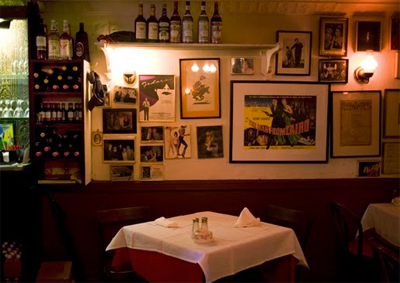
The menu has changed little over time—Italians standards offset classics like ice box cake. Ms. Dorato still prepares some meals. “I never had a cookbook,” she remarked. Born in Florence, Italy and raised in Greenwich Village, she grew up poor. Her mother didn’t let the children help in the kitchen, lest they ruin the food.
“Cooking is fine. I find it very relaxing,” said Ms. Dorato. “But my joy is mixing in with the people.”
Her customers frequently bring in fresh flowers. Red roses are Ms. Dorato’s favorite. As she winds down nearly six decades of running her namesake establishment, she admits to being ready for a break.
“I like my little place, I really do. But my body can’t take it anymore,” she said. “That’s the end of my story.”
Ms. Dorato will remain close by, however. She lives on the third floor of the brownstone. Her son runs his dental practice in the building as well.
For Ms. Dorato’s regulars, the coming days at Fedora will mark the end of an era with their favorite restaurateur—a woman who welcomed them long before many of her neighbors did and who treats newcomers just as warmly.
“She was always ahead of her time,” said Mr. Rooney before paying his bill. “If the whole world looked at things the way she did, it would be such a pleasant place.”
January 15, 2010 |
This article was originally published in Greenwich Village Block News, a print publication in New York’s Greenwich Village.
Ninety Bedford Street once occupied a shoe store. An interior door led to former speakeasy Chumley’s (which is rumored to reopen). Today, that address is home to The Little Owl. If you’re in the right seat, you can look out the window to see how the restaurant got its name. At Bedford and Grove sits a wooden building—the oldest one in the West Village—and on the corner of the roof is a statue of an owl.
When owner and executive chef Joey Campanaro was renovating, paper covered the windows. When he pulled it down, he saw the statue and settled on the name. Because the building is landmarked, the red walls and blue awning that preceded the eatery remain intact. You might recognize them from Friends—the location was used as the exterior setting for the sitcom.
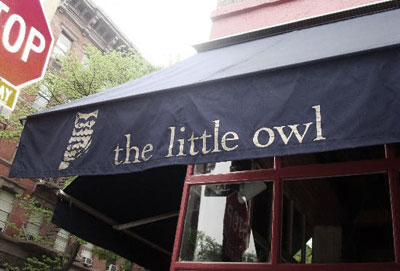
Despite the economy, the place is always full—reservations are taken up to a month in advance (and are wisely suggested). You can of course take your chances without one. Of the 32 seats in the restaurant, the four at the bar can’t be reserved.
While it lacks the legacy of many West Village establishments, The Little Owl has quickly woven itself into the fabric of the neighborhood. I recently sat down with Beverage Director Tracy Gribbon to learn more about what makes the establishment so damn charming.
One thing you’ll notice is that the menu—a reflection of the space—is tiny. It’s manageable…selective. An emphasis on quality, seasonal ingredients stems from longstanding relationships with food purveyors and specialized distributors. “The product is really important to us,” says Tracy. Specials are dictated by what’s freshest and most readily available.
Dishes like the whole fish reveal the Mediterranean influence that is Joey’s specialty, although the gravy meatball sliders are the most coveted item on the menu. The recipe is included here, compliments of the chef.
If you crave a martini before the sliders, you’re out of luck. Your options are beer or wine. Licensing was the initial reason for not offering hard alcohol. But management soon realized they enjoyed the ease of serving only beer and wine. Besides that, a full bar would require expertise in spatial configuration. Tracy has concocted a handful of wine-based cocktails. The Fraise Passé, a blend of lemonade, vin blanc, sparkling wine, and fresh strawberry juice is particularly refreshing.
While she’s held nearly every position imaginable in the industry, Tracy started out at a Jewish deli in Atlanta. Fourteen at the time, she was relied on to deal with a few ornery regulars (and she was good at it). Now responsible for the entire wine selection, she enjoys getting to know winemakers and reps. After meeting with Kyle MacLachlan, she added his cabernet sauvignon, Pursued By Bear, to the offerings. You’re more likely to see celebrities dining rather than promoting wines, however. Barbara Bush showed up not long ago.
Regardless of any luminary appeal, The Little Owl remains friendly and unassuming. Joey’s team is a close one, which explains the affable respect with which they treat their customers. As Tracy says, “We’re in the business of providing a good time, so we should enjoy it.”
The Little Owl’s Gravy Meatball Sliders
Ingredients
1/2 pound ground beef
1/2 pound ground pork
1/2 pound ground veal
1/2 cup panko (Japanese breadcrumbs)
1/2 cup water
8 tablespoons freshly grated Pecorino Romano cheese, divided
1 large egg
1 large egg yolk
1/4 cup plus 2 tablespoons chopped fresh parsley
1 teaspoon salt
1/2 teaspoon ground black pepper
1/4 cup vegetable oil
2 tablespoons olive oil
1 cup chopped onion
6 garlic cloves, chopped
1/4 cup (packed) fresh basil leaves
1 1/2 teaspoons fennel seeds
1 28-ounce can whole peeled tomatoes
1 14.5-ounce can whole peeled tomatoes
Arugula leaves (optional)
18 small soft rolls, split horizontally
Preparation
Mix all meats, panko, 1/2 cup water, 6 tablespoons cheese, egg, egg yolk, 1/4 cup parsley, 1 teaspoon salt, and 1/2 teaspoon black pepper in large bowl. Form into eighteen 2-inch-meatballs.
Heat vegetable oil in large skillet over medium-high heat. Working in batches, fry meatballs until brown all over. Transfer to plate. Pour off drippings from skillet. Reduce heat to medium. Add olive oil to skillet. Add onion, garlic, basil and fennel seeds. Sauté until onion begins to brown, about 5 minutes. Add all tomatoes with juices. Bring to boil, scraping up browned bits. Reduce heat to low, cover with lid slightly ajar, and simmer, stirring occasionally, about 30 minutes.
Puree sauce in processor until almost smooth. Return to same skillet. Add meatballs. Cover with lid slightly ajar and simmer until meatballs are cooked through, stirring occasionally, about 30 minutes longer.
Place arugula leaves on bottom of each roll, if desired. Top each with 1 meatball. Drizzle meatballs with some of sauce and sprinkle with remaining 2 tablespoons parsley and 2 tablespoons cheese. Cover with tops of rolls. Makes 6 servings.
Enjoy!
February 1, 2009 |
This article was originally published in WestView, a print publication in New York’s West Village.
Oh, the sweets to be found in the West Village—chocolate chip bread pudding at Blue Ribbon Bakery, profiteroles at August, banoffee pie at the Spotted Pig, the list goes on. There is one West Village treat, however, that I place above all others. It makes Jacques Torres hot chocolate seem ordinary and turns Magnolia cupcakes into dog scraps.
This dessert, though served at Café Cluny, is baked in TriBeCa and shipped gently up to the neighborhood. I speak of their beloved dark chocolate torte. If you have yet to try it, drop this paper immediately and find your way over to the corner of West 4th and West 12th Streets. It is a rich slice of perfection, topped with a dollop of mascarpone.

Because of Café Cluny’s pint-sized kitchen, the torte is made at sister restaurant, The Odeon. Both are owned by Lynn Wagenknecht and partners, as is Café Luxembourg. Jackie Zion, pastry chef at The Odeon, invited me into the kitchen to learn how to make this delectable treat.
As she prepped her station, I learned about Jackie’s first job, one that set her down a culinary path. At age 14, she worked at a Dairy Queen in Bergen County, New Jersey. In between making Blizzards, changing mixers, and decorating cakes, she realized how much fun she had bustling around a kitchen. She also learned a valuable lesson early on. “When you see somebody with an ice cream cone,” she said, “they’re just so happy.” This simple truth stayed with her.
Jackie went on to study fine arts but became disenchanted with the growing emphasis on digital techniques. She yearned for something more tangible and soon enrolled in the New York Restaurant School to study as a pastry chef. “I’m a bad cook,” she said, explaining that what she loves about baking as opposed to cooking is the precision it demands.
Aside from making all of the desserts for Café Cluny and The Odeon (their menus have little overlap), she makes ice cream for Café Luxembourg. Jackie enjoys making this versatile sweet because it gives her a chance to explore endless flavors. The day of my visit, I helped her fold melted chocolate into mint ice cream to make mint chocolate chip. She had steeped mint leaves in the milk and cream to give it its refreshing flavor.
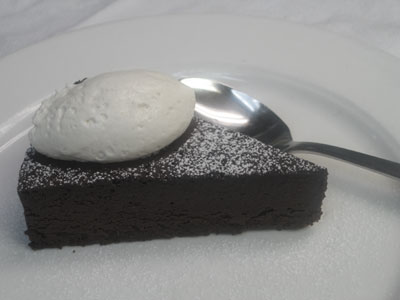
The dark chocolate torte has been on the menu at Café Cluny for about a year. One of the restaurant owners had shared with Jackie a recipe that she began toying with. The original called for solely unsweetened chocolate. She instead balances equal parts unsweetened and 72% chocolate. Her favored brand is San Francisco-based Guittard. (Coincidentally, my former boss is now part of the Guittard family.)
As Jackie made the dessert, I picked up a few tips, such as relying on superfine sugar because it dissolves better, and using kosher salt for its taste. For melting the chocolate, Jackie first combines water with butter and sugar over heat. She then removes the mixture from the stovetop and folds the chocolate to smoothly melt it in.
The torte is less complicated to make than I had anticipated, and the finished product is delicious. It is a lovely blend of bittersweet flavor and a creamy, almost ganache-like texture. The accompanying mascarpone is unsweetened, though Jackie had me try it sweetened, which is her preference. It’s nice, but I am partial to the former. Be warned, this dessert is rich. You may want to split a slice. Or pair it with a glass of red wine and call it dinner.
Café Cluny Dark Chocolate Torte
6 oz. 72% chocolate
6 oz. unsweetened chocolate
5 eggs
1 cup plus 2 Tbs. superfine sugar
8 oz. unsalted butter
1 cup water (plus more for water bath)
Pinch of kosher salt
Preheat oven to 300 degrees. Whip eggs with 1/3 of the sugar and a pinch of salt for ten minutes or until the size quadruples. Heat the rest of the sugar with water and butter in a small saucepan. Once melted, remove the pan from the heat and add the chocolate. Whisk until the chocolate has melted. Combine this with the egg mixture, blending until smooth. Pour into a 9-inch pan and bake in a water bath (add water to the height of the batter) for 30 minutes. Let set once it is out of the oven. Serve warm, sprinkled with powdered sugar. Place a dollop of mascarpone on each slice.








